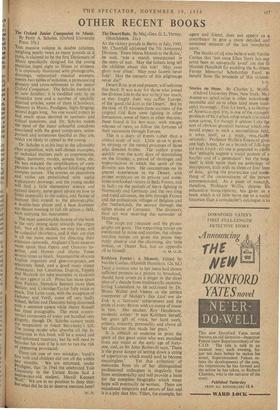OTHER RECENT BOOKS
THIS massive volume in double columns, Weighing nearly twice as many pounds as it Costs, is claimed to be the first Dictionary of Music specifically designed for the young Musician, (aged eight to fifteen or sixteen). It is copiously illustrated with. photographs, drawings, substantial musical excerpts, twenty-two tables of notation, a pronouncing glossary and cross-references to the senior Oxford Companion. The Scholes method is by now familiar; it is modified only by an avuncular tone and a number of specially directed articles, some of them (Choirboys, Memory in Music, Prodigies, Sight-Singing)
several pages long. No one would expect to find much space devoted to aesthetic and critical questions, and Dr. Scholes makes the most of the many colourful anecdotes 'associated with the great composers, unim- .Portztnt and sometimes fanciful as they are, which are likely to appeal to the young.
Dr. Scholes is at his best in the admirably clear exposition, with well chosen examples,
of technical matters such as counterpoint,
fugue; harmony, modes, sonata form, etc. He has reduced the simplification of com- Plexities to a fine art, without falsifying their complex nature. The articles on pianoforte and violin are embellished with useful explanatory drawings, and the young reader will find a little elementary science and natural history, some good advice on how to listen (especially to the radio), and flashes of humour that extend to the photographs: a double-bass player and a bass drummer are shown running at full tilt across a field, each carrying his instrument.
The most questionable feature of the book is the very strong slant towards the organ loft. Not all its readers; we may hope, will • he cathedral choirboys, and if they arc that is all the more reason for directing their • attention outwards. Anglican Chant receives More space than Opera and Oratorio to- gether, and Hymns and Hymn .Tunes
several times as much. Innumerable obscure English organists and glee-composers are
separately listed, and a good many minor Americans; but Cimarosa, Duparc, Tippett and Warlock (to. take examples at random) do not appear at all. Prout has more space than Puccini, Sterndale Bennett more than Berlioz, and Coleridge-Taylor fully twice as much. The Latin races, with the exception of bebussy and Verdi, come off very badly indeed, Bellini and Donizetti being dismissed
With a sentence apiece while Henry Russell has three paragraphs. The more contro- versial composers of today are handled very gingerly, though Dr. Scholes cannot resist the temptation to tweak Stravinsky's tail.,,,, The young reader who absorbs all the in- formation in this book will be a sound and well-informed musician, but he will need to broaden his taste if he is not to run the risk Of appearing provincial.
There are one or two mistakes: Verdi's first wile and children did not all die within two months. We are informed, under Prodigies , that 'in 1944 the celebrated Yale _University in the United States had a W. D.










































































 Previous page
Previous page